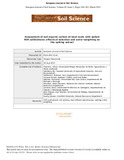JavaScript is disabled for your browser. Some features of this site may not work without it.
| dc.contributor.author | Guerrero, C. | |
| dc.contributor.author | Stenberg, B. | |
| dc.contributor.author | Wetterlind, J. | |
| dc.contributor.author | Viscarra Rossel, R. A. | |
| dc.contributor.author | Maestre, F. T. | |
| dc.contributor.author | Mouazen, Abdul Mounem | |
| dc.contributor.author | Zornoza, R. | |
| dc.contributor.author | Ruiz-Sinoga, J. D. | |
| dc.contributor.author | Kuang, Boyan Y. | |
| dc.date.accessioned | 2016-10-24T14:34:34Z | |
| dc.date.available | 2016-10-24T14:34:34Z | |
| dc.date.issued | 2014-01-17 | |
| dc.identifier.citation | Guerrero, C. et al. (2014) Assessment of soil organic carbon at local scale with spiked NIR calibrations: effects of selection and extra-weighting on the spiking subset. European Journal of Soil Science, Volume 65, Issue 2, pp. 248-263 | en_UK |
| dc.identifier.issn | 1351-0754 | |
| dc.identifier.uri | http://dx.doi.org/10.1111/ejss.12129 | |
| dc.identifier.uri | https://dspace.lib.cranfield.ac.uk/handle/1826/10850 | |
| dc.description.abstract | Spiking is a useful approach to improve the accuracy of regional or national calibrations when they are used to predict at local scales. To do this, a small subset of local samples (spiking subset) is added to recalibrate the initial calibration. If the spiking subset is small in comparison with the size of the initial calibration set, then it could have little noticeable effect and a small improvement can be expected. For these reasons, we hypothesized that the accuracy of the spiked calibrations can be improved when the spiking subset is extra-weighted. We also hypothesized that the spiking subset selection and the initial calibration size could affect the accuracy of the recalibrated models. To test these hypotheses, we evaluated different strategies to select the best spiking subset, with and without extra-weighting, to spike three different-sized initial calibrations. These calibrations were used to predict the soil organic carbon (SOC) content in samples from four target sites. Our results confirmed that spiking improved the prediction accuracy of the initial calibrations, with any differences depending on the spiking subset used. The best results were obtained when the spiking subset contained local samples evenly distributed in the spectral space, regardless of the initial calibration's characteristics. The accuracy was improved significantly when the spiking subset was extra-weighted. For medium- and large-sized initial calibrations, the improvement from extra-weighting was larger than that caused by the increase in spiking subset size. Similar accuracies were obtained using small- and large-sized calibrations, suggesting that incipient spectral libraries could be useful if the spiking subset is properly selected and extra-weighted. When small-sized spiking subsets were used, the predictions were more accurate than those obtained with ‘geographically-local’ models. Overall, our results indicate that we can minimize the efforts needed to use near-infrared (NIR) spectroscopy effectively for SOC assessment at local scales. | en_UK |
| dc.language.iso | en | en_UK |
| dc.publisher | Wiley | en_UK |
| dc.rights | This is the pre-peer reviewed version of the following article: Guerrero, C. et al. (2014) Assessment of soil organic carbon at local scale with spiked NIR calibrations: effects of selection and extra-weighting on the spiking subset, European Journal of Soil Science, Vol. 65, Iss. 2, pp. 248-263, which has been published in final form at http://dx.doi.org/10.1111/ejss.12129. This article may be used for non-commercial purposes in accordance with Wiley Terms and Conditions for Self-Archiving. http://olabout.wiley.com/WileyCDA/Section/id-828039.html#submitted | en_UK |
| dc.title | Assessment of soil organic carbon at local scale with spiked NIR calibrations: effects of selection and extra-weighting on the spiking subset | en_UK |
| dc.type | Article | en_UK |
Files in this item
This item appears in the following Collection(s)
-
Staff publications (SATM) [4365]
